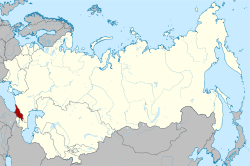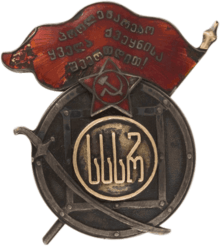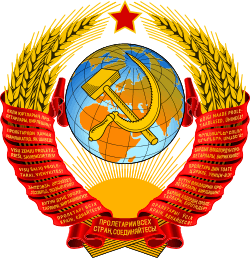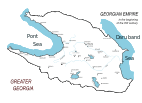Georgian Soviet Socialist Republic
| Georgian Soviet Socialist Republic | ||||||||||||||||||
| საქართველოს საბჭოთა სოციალისტური რესპუბლიკა Грузинская Советская Социалистическая Республика Gruzinskaya Sovetskaya Sotsialisticheskaya Respublika | ||||||||||||||||||
| ||||||||||||||||||
| ||||||||||||||||||
| Anthem Anthem of the Georgian SSR | ||||||||||||||||||
 Location of the Georgian SSR (red) within the Soviet Union. | ||||||||||||||||||
| Capital | Tbilisi | |||||||||||||||||
| Languages | Georgian Russian Abkhaza Ossetianb | |||||||||||||||||
| Government | Soviet Socialist Republic | |||||||||||||||||
| First Secretary | ||||||||||||||||||
| • | 1921–1922 | Mamia Orakhelashvili | ||||||||||||||||
| • | 1989–1990 | Givi Gumbaridze | ||||||||||||||||
| Chairman of The Council of Ministers | ||||||||||||||||||
| • | 1946 | Valerian Bakradze | ||||||||||||||||
| • | 1990–1991 | Tengiz Sigua | ||||||||||||||||
| History | ||||||||||||||||||
| • | Soviet invasion and occupation | 11 February 1921 | ||||||||||||||||
| • | Formation | 25 February 1921 | ||||||||||||||||
| • | Admitted to USSR | 30 December 1922 | ||||||||||||||||
| • | TSFSR dissolved | 5 December 1936 | ||||||||||||||||
| • | Sovereignty declared | 18 November 1989 | ||||||||||||||||
| • | Renamed to Republic of Georgia | 18 November 1990 | ||||||||||||||||
| • | Independence declared | 9 April 1991 | ||||||||||||||||
| • | Independence recognized | 26 December 1991 | ||||||||||||||||
| • | New official constitution | 24 August 1995 | ||||||||||||||||
| Area | ||||||||||||||||||
| • | 1989 | 69,700 km² (26,911 sq mi) | ||||||||||||||||
| Population | ||||||||||||||||||
| • | 1989 est. | 5,400,841 | ||||||||||||||||
| Density | 77.5 /km² (200.7 /sq mi) | |||||||||||||||||
| Calling code | +7 881/882/883 | |||||||||||||||||
| ||||||||||||||||||
| Today part of | | |||||||||||||||||
| a. | In the Abkhazian ASSR. | |||||||||||||||||
| b. | In the South Ossetian AO. | |||||||||||||||||

The Georgian Soviet Socialist Republic, (Georgian SSR; Georgian: საქართველოს საბჭოთა სოციალისტური რესპუბლიკა, translit.: sakartvelos sabch'ota sotsialist'uri resp'ublik'a; Russian: Грузинская Советская Социалистическая Республика Gruzinskaya Sovetskaya Sotsialisticheskaya Respublika) also commonly known as Soviet Georgia or simply known as Georgia, was one of the republics of the Soviet Union from its inception in 1922 to its breakup in 1991.
It is coterminous with the present-day republic of Georgia, a pre-existing country in the Caucasus which gained autonomy as a constituent republic of the Union of Soviet Socialist Republics after being annexed by the Russian Empire in 1810 and in 1921 by the Russian Soviet Federative Socialist Republic. From November 18, 1989, the Georgian SSR declared its sovereignty over Soviet laws. The republic was renamed to the Republic of Georgia on November 14, 1990 and subsequently became independent before the dissolution of the Soviet Union on April 9, 1991, whereupon each former SSR became a sovereign state. The Soviet Georgian state officially ended on August 24, 1995 when the new official constitution of Georgia was ratified.
Geographically the Georgian SSR was bordered by Turkey to the south-west and the Black Sea to the west. Within the Soviet Union it bordered the Russian SFSR to the north, Armenian SSR to the south and the Azerbaijan SSR to the south-east.
History
Establishment
On November 28, 1917, after the October Revolution in Russia, there was a Transcaucasian Commissariat headed by Mensheviks established in Tiflis (from 1936 on Tbilisi).
The Socialist Soviet Republic of Georgia was established on February 25, 1921.[1] On March 2 of the following year the first constitution of Soviet Georgia was accepted.
Transcaucasian Federative Republic
From March 12, 1922 to December 5, 1936 it was part of the Transcaucasian SFSR together with the Armenian SSR and the Azerbaijan SSR. In 1936, the TSFSR was dissolved. During this period the province was led by Lavrentiy Beria, first secretary of the Georgian Central Committee of the Georgian Communist Party[2] The Soviet Government forced Georgia to cede several areas to Turkey (the province of Tao-Klarjeti and part of Batumi province), Azerbaijan (the province of Hereti/Saingilo), Armenia (the Lore region) and Russia (northeastern corner of Khevi, eastern Georgia).
In 1936, the TFSSR was dissolved and Georgia became the Georgian Soviet Socialist Republic.
Lavrentiy Beria became head of the Georgian OGPU and purged Georgia until he was transferred to Moscow in 1938.
World War II
Reaching the Caucasus oilfields was one of the main objectives of Hitler's invasion of the USSR in June 1941, but the armies of the Axis powers did not get as far as Georgia. The country contributed almost 700,000 fighters (350,000 were killed) to the Red Army, and was a vital source of textiles and munitions. During this period Stalin (born in Georgia) ordered the deportation of the Chechen, Ingush, Karachay and the Balkarian peoples from the Northern Caucasus; they were transported to Siberia and Central Asia for alleged collaboration with the Nazis. He abolished their respective autonomous republics. The Georgian SSR was briefly granted some of their territory until 1957.[3]
Post-Stalin period
On March 9, 1956, about a hundred Georgian students were killed when they demonstrated against Nikita Khrushchev's policy of de-Stalinization that was accompanied by general criticism of the whole Georgian people and culture.
The decentralisation program introduced by Khrushchev in the mid-1950s was soon exploited by Georgian Communist Party officials to build their own regional power base. A thriving pseudo-capitalist shadow economy emerged alongside the official state-owned economy. While the official growth rate of the economy of the Georgia was among the lowest in the USSR, such indicators as savings level, rates of car and house ownership were the highest in the Union,[4] making Georgia one of the most economically successful Soviet republics. Corruption was at a high level. Among all the union republics, Georgia had the highest number of residents with high or special secondary education.[5]
Although corruption was hardly unknown in the Soviet Union, it became so widespread and blatant in Georgia that it came to be an embarrassment to the authorities in Moscow. Eduard Shevardnadze, the country's interior minister between 1964 and 1972, gained a reputation as a fighter of corruption and engineered the removal of Vasil Mzhavanadze, the corrupt First Secretary of the Georgian Communist Party. Shevardnadze ascended to the post of First Secretary with the blessings of Moscow. He was an effective and able ruler of Georgia from 1972 to 1985, improving the official economy and dismissing hundreds of corrupt officials.
Soviet power and Georgian nationalism clashed in 1978 when Moscow ordered revision of the constitutional status of the Georgian language as Georgia's official state language. Bowing to pressure from mass street demonstrations on April 14, 1978, Moscow approved Shevardnadze's reinstatement of the constitutional guarantee the same year. April 14 was established as a Day of the Georgian Language.
End of the Soviet period
.svg.png)
Shevardnadze's appointment as Soviet Foreign Minister in 1985 brought his replacement in Georgia by Jumber Patiashvili, a conservative and generally ineffective Communist who coped poorly with the challenges of perestroika. Towards the end of the late 1980s, increasingly violent clashes occurred between the Communist authorities, the resurgent Georgian nationalist movement and nationalist movements in Georgia's minority-populated regions (notably South Ossetia). On April 9, 1989, Soviet troops were used to break up a peaceful demonstration at the government building in Tbilisi. Twenty Georgians were killed and hundreds wounded and poisoned. The event radicalised Georgian politics, prompting many - even some Georgian communists - to conclude that independence was preferable to continued Soviet unity.
On October 28, 1990, democratic parliamentary elections were held, and on November 15 the nation was renamed the "Republic of Georgia." Georgia (excluding Abkhazia) was one of the six republics along with Armenia, Moldova and the Baltic States who boycotted the participation of the union-wide preservation referendum in March. It declared independence on April 9, 1991, under Zviad Gamsakhurdia, as one of the republics to secede just four months before the failed coup against Gorbachev in August which was one of the republics to support it. However, this was unrecognized by the Soviet government and Georgia was in the Soviet Union until its collapse in December 1991. On August 24, 1995, on the basis of the constitution of the Georgian Democratic Republic in 1921, a new Constitution of Georgia was adopted on which the country's name changed to Georgia.[6]
Footnotes
- ↑ The Europa World Year Book 2004, Volume I. Europa World Year Book (45th ed.). London: Europa Publications. 2004 [1928]. p. 1806. ISBN 1-85743-254-1.
However, Georgia was invaded by Bolshevik troops in early 1921, and a Georgian Soviet Socialist Republic (SSR) was proclaimed on 25 February.
- ↑ .Geronti Kikodze (1954) Notes of a Contemporary, first published in 1989, Mnatobi, Issue 1, Tbilisi, Georgia.
- ↑ Parrish, Michael (1996). The Lesser Terror: Soviet State Security, 1939-1953. Greenwood Publishing Group. p. 102. ISBN 0-275-95113-8.
- ↑ Gregory Grossman, ‘The "Second Economy" of the USSR’, Problems of Communism, vol. 26 no. 5, 1977, quoted from Cornell, Svante E., Autonomy and Conflict: Ethnoterritoriality and Separatism in the South Caucasus – Case in Georgia. Department of Peace and Conflict Research, Report No. 61. p. 149. University of Uppsala, ISBN 91-506-1600-5.
- ↑ Suny, Ronald G.; James Nichol; Darrell L. Slider (1996). Armenia, Azerbaijan, and Georgia. DIANE Publishing. p. 186. ISBN 0-7881-2813-2.
- ↑ (Russian) Georgian Ministry of Foreign Affairs - The Constitution of Georgia
Further reading
- Stephen Jones, "The Establishment of Soviet Power in Transcaucasia: The Case of Georgia 1921-1928," Soviet Studies, vol. 40, no. 4 (Oct. 1988), pp. 616–639.
 Map of the Georgian & Abkhazian Socialist Soviet Republics in 1922-1931
Map of the Georgian & Abkhazian Socialist Soviet Republics in 1922-1931 Map of the Georgian Soviet Socialist Republic in 1931-1943
Map of the Georgian Soviet Socialist Republic in 1931-1943.jpg) Map of the Georgian Soviet Socialist Republic in 1944-1955
Map of the Georgian Soviet Socialist Republic in 1944-1955 Map of the Georgian Soviet Socialist Republic in 1957-1991
Map of the Georgian Soviet Socialist Republic in 1957-1991
External links
- Georgia, land of the Golden Fleece, reveals its riches a propaganda pamphlet about the GSSR from the 1960s.
- Avalishvili, Levan: "The “Great Terror” of 1937–1938 in Georgia: Between the Two Reports of Lavrentiy Beria" in the Caucasus Analytical Digest No. 22
- Anchabadze, George: "Mass Terror in the USSR: The Story of One Family" in the Caucasus Analytical Digest No. 22




